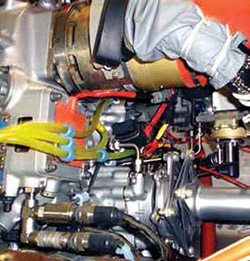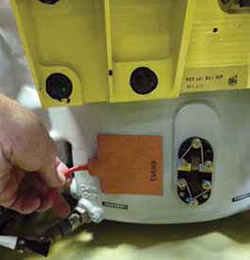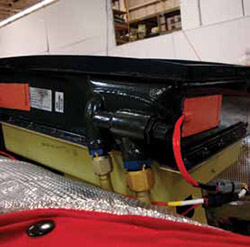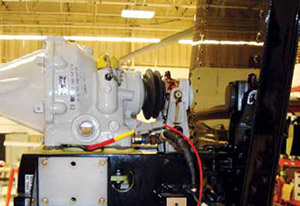
BRRR...IT’S COLD OUTSIDE TANIS PREHEAT SYSTEMS FOR HELICOPTER




I am in my office in Glendale, AZ, about four miles north of the Phoenix Cardinals football stadium, where for weeks in August the temperatures averaged around 112 degrees. Preheating an aircraft is not what I would normally be thinking about. However, if you operate a helicopter or fleet of helicopters where winters get pretty cold and preheat systems are a necessity, you probably begin preparing for old man winter as early as August.
Why Tanis Preheat?
“Tanis manufactures the only heli-preheat system that thoroughly and safely heats all critical helicopter components including engine, engine reduction and accessory cases, oil, hydraulic tanks, fuel control units, and main and tail rotor gear boxes,” says Dirk Ellis, Tanis Engineering manager. “Direct application of heat assures thorough heat is applied in a safe, reliable manner which reduces maintenance costs and fuel consumption. Quite simply, preheating adds to operational reliability, utility and flight safety, ensuring reliable starts in all weather conditions.”
Doug Evink, Tanis president and CEO states that, “Tanis stands for the most technologically-advanced aircraft preheat systems. A Tanis system is the only solution to provide heat to all critical helicopter components.”
The preheat system is not used in flight. Systems are available in two separate voltages, 115vAC and 230vAC. Power is provided by a ground/shoreline source. The system is not connected to or dependent upon any existing aircraft systems. Voltage requirements are identified by power plug type, placards and flight manual supplements. Circuit protection requirements do not exceed 12 amps.
The 115vAC and 230vAC systems not only differ by power requirements, but component part numbers also identify voltage requirements. These parts include the power plug, indicator light and heating elements. Voltage-dependent parts use the same installation process, locations and wiring kit.
Preheating the aircraft components is accomplished through heat pad elements mounted to the components surface with an approved bonding adhesive. Power is applied to the heat pads through an independent wiring assembly that is routed with existing wiring and using accepted shop practices. The photos that accompany this article show some of the places where the Tanis preheat pads (flat and orange colored) are installed on a Bell 429 helicopter. Tanis Aircraft Products provided the photos.
How Long to Preheat?
Tanis’ preheat system is designed to “heat soak” an aircraft engine to approximately 60 degrees over ambient temperature in approximately six hours. This is a general guideline, dependent on variations in systems and engine applications.
MX Issues
Unable to Start Due to Cold Weather
The main reason that a turbine engine will not start when cold soaked is that the gear boxes and bearing surfaces are going to be tight due to thermal expansion of the different metals and other materials. This means that the bearings which may be steel are housed in an aluminum box running on stainless-steel races and are all going to be at the extremes of their normal operational tolerance. They may not function together properly when at extremes.

This is compounded by the fact that when you try to start the engine, you are basically throwing fire at the vanes and heating them until everything comes back into tolerance and the shafts and bearings can move freely again.
Damage Caused by Starting
Starting the helicopter engine causes more stress to the engine components than just about any other operation. This is due to thermal shock and wear.
When starting a cold-soaked engine, there are a multitude of damages that can occur, from having excessive wear on a bearing/shaft from poor lubrication, to a seal that has become frozen to a shaft, or even damage to a shaft from excessive stresses due to back pressures on it.
Some water willwork its way into the gear boxes and engines, and that water may form ice on bearing surfaces that can force bearings to slip on shafts, or not move efficiently. Any blockage to the oil system may also cause issues with a bearing running dry.
Many of these damages do not occur on a single start, rather they happen over time and slowly chip away at a component’s health. For example, a new gear box seal may be perfect at normal temperatures, but it may be too tight on a cold shaft because it hasn’t worn in. That is why there normally is a wear-in phase for an engine or main drive component on any vehicle.
When drag on the accessory gears and drive components is significantly reduced, the acceleration of the engine is greater/faster. Consequently, peak gas temperatures experienced during start are shorter in terms of duration and are cooler.
Hot Starts
When starting, it is common practice to warm the engine with a run up, but what is really happening when a helicopter is forced to start when it is cold soaked? Often much larger forces are created that push much harder on the engine. This creates localized heat which can raise the temperature of that particular engine section drastically in a short time. This leads to thermal stresses in the materials and can cause cracking, fatigue and blown seals.
A “hung start” can also happen at this point if the engine fails to accelerate and the rpms stays constantly low. This uses up battery power. If the battery runs out of power then the engine slows down, less and less cold air is drawn through the engine, and subsequently the temperature in the combustion chamber becomes really hot within a few seconds and causes a lot of damage.
Preheating lubricants, accessories and driveline components result in a reduction in drag, impact torque, etc., during engine start and run-up procedures. Fuel vaporization is also improved. The results are a reduction in start times, less wear and tear on the starting system (i.e., starter/generator, battery and combustion section). Thermal stress in the C-section is a function of both peak temperature and time of exposure. Proper preheating reduces both and yields a second order reduction.
Diminished Battery Capacity
Preheating aircraft batteries eliminates freeze point depression. This condition causes unheated batteries to lose their load function and ability to receive a charge.
Many operators have concerns regarding batteries. Their concerns are valid not only with regard to starting capabilities, but more importantly the batteries’ ability to receive and maintain a charge when temperatures are extreme. There are a number of other electrical concerns centered around the starter generator, power surge and increased loads imposed on electrical systems during cold weather starting as well.
Blown Out Oil Filter Seals and Hydraulic Lines Due to Congealed Oil
Why is the oil filter’s location always the most common place for an oil system to leak? Because it was designed that way. Most oil systems are set up so that they use a pressure fitting around the oil filter to allow excess pressure or gases to escape the system. But what happens when you have congealed oil in your large cold oil filter? It causes a pressure rise until the oil can warm enough to flow properly. This also can affect lines in much the same way because the lines can be made impossible to have proper flow from congealed oil. If the pump is adding pressure, it has to go someplace.
Mechanical and Electrical Stress to Systems
Many people believe that computers are better kept cold. They are correct, but a monitor may not be able to handle the cold the same as a computer does. For instance, an LCD screen may not be able to power on fully at 40 degrees. It may take hours of being at this “partially-on” state to heat itself to normal operating temperature. It will eventually operate correctly but the display may be slow and/or unresponsive until that happens.
If you have spinning mass gyros in your aircraft, it may take considerable time to heat up the lubrication in the gyro, which means the gyro will not erect anytime soon. This means that they are not operational and “OFF” flags are still displayed. The aircraft is not going anywhere until the gyros are operational. They will move improperly while cold, and this adds stress and wear to them. The reduction of condensation on any electrical device can increase its useful life. Preheating flight deck avionics, displays and gyros reduces condensation, corrosion, gyro wear and cold weather-induced avionic problems.
Increased Operational Times/Takeoff Readiness
With increased engine run-up time comes an additional fuel cost fuel. You use fuel and time by idling to warm the engine. When minutes count in your spool-up time, starting at an already-increased temperature that is consistent over the entire power train is a no brainer. You can take off faster due to not having to run up to add that heat to an aircraft that is generally built to dissipate heat from the engine and drive train.
Ok, Tanis has me convinced. If I operated an aircraft in cold environments, a preheat system certainly makes sense. Of course, the winters here in the Phoenix area are really something else. Those three days I am pretty much homebound and can’t get out to the golf course.
About Tanis Aircraft Products
Peter Tanis developed and patented the first multi-point engine preheat system in 1973 to address the inherent problems in starting piston engines in cold weather. In 1981, he added helicopter preheat systems to the product line. He continued to operate and expand the business until his death in 2000. The company was eventually purchased in 2006 by Robert Krueger who recently added Evink as an equity partner.
Today, Tanis Aircraft Products sells an array of products for the aviation industry. Tanis continues a tradition as the leading supplier of aircraft engine preheaters worldwide. The company invests heavily in research and development. Most of the company’s components and products are FAA-PMA certified. Tanis Aircraft Products are manufactured at its facility in Glenwood, MN. Its corporate offices are located in Eden Prairie, MN.
